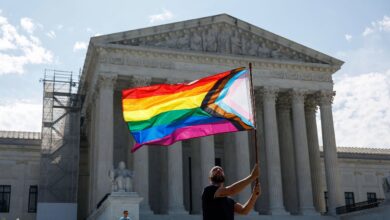Montrose Rainbow Crosswalks Removed During Repaving, Future in Question
Federal guidelines put return of Houston’s LGBTQ landmark on hold.

Montrose’s iconic rainbow crosswalks — a landmark honoring Houston’s LGBTQ community — have been removed during a repaving project and may not return soon, according to local officials.
The rainbow-striped intersection at Westheimer and Taft, first installed in 2017, was taken out as METRO crews completed federally funded improvements along the Westheimer corridor. While the agency has pledged that it is “prepared to restore the rainbow crosswalk striping … to its pre-repair condition,” it also said the final decision depends on new federal guidelines and a review by city leaders.
“We are currently awaiting the City of Houston and METRO leadership’s review of recent federal guidelines and stakeholder feedback before proceeding,” METRO told Houston Public Media.
Those guidelines, issued under the Trump administration, have cast doubt on the crosswalks’ return. In July, U.S. Transportation Secretary Sean Duffy called for the removal of what he described as political messaging on public roadways.
“Taxpayers expect their dollars to fund safe streets, not rainbow crosswalks,” Duffy wrote in a July 1 post on X. “Political banners have no place on public roads. I’m reminding recipients of [USDOT] roadway funding that it’s limited to features advancing safety, and nothing else.”
For now, the intersection looks like any other: standard white-striped pedestrian lanes. METRO spokesperson Anna Carpenter emphasized that design decisions ultimately fall to the City of Houston. “METRO’s role is to implement the work and continue providing safe, reliable, and accessible service,” she said.
City Council Member Abbie Kamin, who represents Montrose, said she remains committed to restoring the rainbow design.
“I know a lot of folks in the community are nervous right now seeing what’s happening around the country,” Kamin told Houston Public Media. “If the federal government wants to waste their time focusing on a crosswalk in Houston, that should show you where their priorities are, rather than focusing on our economy, on public safety, on critical needs such as flooding.”
The rainbow crosswalks were funded by Pride Houston 365, the nonprofit behind the city’s annual Pride parade and festival. Installed in memory of Alex Hill, a 21-year-old who was killed by a hit-and-run driver at the intersection in 2016, the project was the first of its kind in Texas.
Kamin described the decision on whether to repaint the crosswalks as “a true partnership” between METRO and the city, though she acknowledged that federal rules could complicate the process.
She characterized the likely timeline as “within the coming weeks,” adding that she hopes to see the original rainbow colors — red, orange, yellow, green, blue, violet, and white — back on the pavement soon.
“If there is some unforeseen reason that it is not put back,” Kamin said, “residents are going to get to see their council member out on Taft in coveralls with some paint rollers myself.”
A community petition online to demand the restoration of the crosswalks has already garnered over 200 signatures.
As federal directives on roadway markings continue to ripple through Texas and beyond, the fate of Montrose’s rainbow crosswalks remains uncertain. For many in Houston’s LGBTQ community, though, their symbolism has never been more vital.










